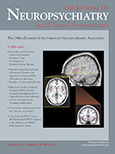Neuroleptic Malignant Syndrome Probably Induced by Asenapine
To the Editor: The neuroleptic malignant syndrome (NMS) has become less frequent with the increasing use of new-generation antipsychotics but continues to be a looming threat in all patients exposed to antidopaminergic drugs. A high index of suspicion is necessary because the onset of the NMS tends to be sudden, and evolution, even in initially mild forms, may be fulminant within 24–72 hours.1
This is the first reported case of NMS probably induced by asenapine.
Case Report
A 22-year-old woman presented with a manic episode with auditory hallucinations, delusions of reference, and persecution. She started aripiprazole 5 mg/day, valproate 500 mg/day, and idroxizine 25 mg at bed time, with remission of the psychotic symptoms. She developed hypersalivation, akathisia, and mild hyperthermia (37.2°C). Rigidity and akinesia were absent. Aripiprazole was reduced to 2.5 mg/day. Two weeks later, she presented again with delusions, hallucinations, and thought disorder. Aripiprazole was increased to 7.5 g/day with worsening of psychotic symptoms and onset of insomnia. Neither hyperthermia nor catatonic symptoms were present. Then, aripiprazole was substituted with asenapine 5 mg at bed time. The following night, she slept well, and the day after she appeared improved. Twenty hours later, she suddenly presented with disorganized thought, unusual posturing, mild rigidity, hyperthermia (37.8°C), tachycardia, sweating, and agitation. She stopped taking asenapine, continued valproate and idroxizine, and started lorazepam 1 mg, three times per day. The day after, the fever, thought disorder, abnormal posturing, rigidity, and psychotic symptoms stopped. She continued the same therapy in the next 4 weeks with progressive improvement. Neither psychotic symptoms nor abnormal movements or hyperthermia recurred in the following month, and she gradually resumed normal functioning.
Discussion
In this case, the diagnosis of NMS appears likely not only because of the presence of symptoms meeting the criteria of Addonizio et al.2 a few hours after the introduction of a new antipsychotic, but also for the prompt improvement after the withdrawal of the drug. However, it is not possible to exclude the alternative diagnosis of malignant catatonia, a syndrome described by Kahlbaum3 in the preneuroleptic era. From the symptoms, it is impossible to differentiate NMS from malignant catatonia. Nevertheless, iatrogenic disorders resembling natural illnesses should have diagnostic priority. NMS can be excluded only in never-treated catatonic patients.
It is not clear what the link is between these two conditions. Actually, catatonic symptoms that spontaneous occur can turn into NMS during treatment with antidopaminergic drugs.4
In the reported case, NMS symptoms stopped immediately with discontinuation of asenapine and lorazepam treatment, and this suggests an etiological link between asenapine and NMS.
All new-generation antipsychotics can cause NMS, although usually in a partial or milder form (DSM-V) that is more difficult to diagnose. It is recommended that patients are advised to monitor body temperature daily in the first month of treatment, frequently monitor blood pressure and heart rate, and report the appearance of sweating or drooling and the sudden worsening of motor symptoms or mental conditions.
1 : The neuroleptic malignant syndrome. J Clin Psychiatry 1980; 41:79–83Medline, Google Scholar
2 : Symptoms of neuroleptic malignant syndrome in 82 consecutive inpatients. Am J Psychiatry 1986; 143:1587–1590Crossref, Medline, Google Scholar
3 : Die Katatonie oder das Spannungsirresein. Eine klinische Form psychischer Krankheit. Berlin, A. Hirschwald, 1874Google Scholar
4 : Catatonia: harbinger of the neuroleptic malignant syndrome. Br J Psychiatry 1991; 158:419–421Crossref, Medline, Google Scholar



